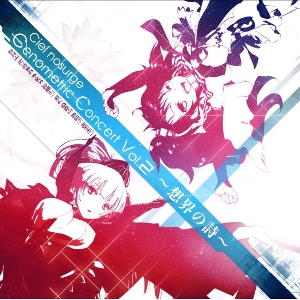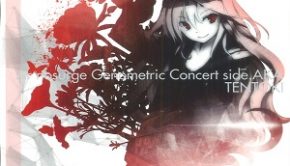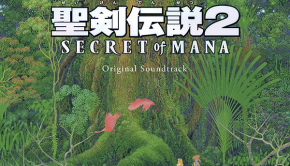Surge Concerto: Ciel nosurge Genometric Concert Vol. 2 -Emotional Songs-
 |
Album Title: Ciel nosurge Genometric Concert Vol. 2 -Emotional Songs- |
| Record Label: Gust |
|
| Catalog No.: FFCT-0037 |
|
| Release Date: August 21, 2013 |
|
| Purchase: Buy at CDJapan |
Overview
Ciel nosurge Genometric Concert Vol.2 -Emotional Songs- is the second part to the vocal albums for Gust’s episodic game Ciel nosurge ~A Song Offered to the Lost Planet~. As it is supposed to be an expansion for an existing game, the sound that was so characteristic to its predecessor album, the Ciel nosurge Genometric Concert vol. 1 -Pact Songs-, is also present here. While unfortunately Akiko Shikata didn’t return for this album, Haruka Shimotsuki and Minami Kizuki reprised their roles, while Noriko Mitose also featured as a vocalists. The compositions were done by Shimotsuki herself, industry veteran Yoshitaka Hirota, and popular doujin musician Morrigan. However, does the album still maintain the high standards its predecessors are known for, or do the new composers and the lack of Shikata here bring down the album?
Body
I’d greatly advise first listening to this album’s predecessor and reading its review in order to understand properly the context for the songs in this one, as the Ar tonelico and Ciel nosurge songs depend greatly on the context in order for their music to give their full impact despite being quite enjoyable listens on their own. Additionally, the first review also works as an introduction to the world of the game, explaining its unique terms and introducing its major characters, so the reader would be lost reading this one first. In other words, this review is a direct sequel to that of the first volume, so please make sure to read about and listen first to volume 1 before starting with volume 2.
Now then, I have to add that Ciel nosurge’s story is divided so far in three arcs: the Trials Arc, the Downfall Arc and the Empress Arc. Volume 1 contained the songs that were used in each of the Trials Arc chapters, while this album contains all of the songs used in the Downfall Arc. From the name alone, you might be imagining that some unpleasant events take place during this volume, and you will see this unfold as you read on.
The first song we come across in this album is a piece called “Beautiful World”. Composed and arranged by Yoshitaka Hirota and sung by Minami Kizuki, this piece is as beautiful as its name suggests. Opening up with a soft choruses, Kizuki begins singing above the backdrop of a calm piano line, percussions, and, upon reaching the second verse, strings. Then the song reaches its hook: Kizuki singing in Japanese with a beautiful chorus singing in Emotional Song Pact behind, which ends with the instrumentation falling silent as she sings the song’s name. The song then gives way to a instrumental bridge followed by a heavenly chorus, which paves the way for the song to repeat its structure to the end. I personally wasn’t very fond of Kizuki before this, but her singing sounds strong , warm and motherly here and showcases once again her Shima-Uta style. The instrumentation is mostly programmed, but it still does a good job of conveying the emotions the song is supposed to transmit: belief in the world and its people, and wishing for them to become even more beautiful on the future.
As for context, this song is sung by Kanoyeel.kkll.Preciel (who will be referred to as Kanon henceforth) during the time she and her political rival, Ionasal (Ion) were at the city of Almetica. As Ion and her friends were being pursued by PLASMA, the secret organization that has a role akin to that of the CIA in the Ciel nosurge world, Kanon decided to help them to escape their clutches by teleporting them to another floating city, or Colon. She also did this to teleport herself to a faraway place called the Genomirai Research Institute, which she did to uncover some secrets that were being withheld from about her birth, which gave rise to rumors on both her and Ion being unfit to be Empress candidates. However, neither Kanon herself or the Genom she synchronized for the singing of this song, ALMETICA, had the energy necessary to execute a teleportation, so ALMETICA temporarily took control of the minds of the citizens of its namesake city, who were in the middle of a festival celebrating the Genoms, and made them sing this same song along Kanon in order to transmit the power of their feelings to her, making the teleportation possible.
The second song of the album, “Code Ethes Wei (Class::ETHES_WEI=>extends.COMMUNI_SAT/.)”, is sung and composed by Haruka Shimotsuki with the arrangement made by Eichiro Yanagi. It basically continues the trend Shimotsuki established for Nay’s character in Vol. 1. The song opens up with Shimotsuki singing in a uplifting way before moving on to a more mellow vocal passage over a soft piano and violin melody with very strong Japanese nuances. After this, some choruses in Emotional Song Pact are added, after which she repeats the previous section but now with some percussions added in and with the rhythm increasing slightly in speed, as well as some koto parts, which she ends by raising her voice tone slightly and letting the entire son fall silent. This gives way to the climax of the song, which she herself described as “if the camera turned away from the singer and focused into the skies above her”, and I have to say it’s quite true: the melody and singing changes as if it had taken off from the ground and the choruses are replaced by Bulgarian-styled choruses, which are a bit later combined with her more normal choruses singing a line in REON-4213. After a very nice bridge, the song repeats the same as the first but with some variations in the percussions, as well as the silence prior to the climax having the percussions louder than in the first time. Additionally, the climax gets extended a bit more, but it then gives way to the end of the song, composed by a short piano melody. Initially the song sounds uplifting to then give off a feeling of doubt and unconformity, but it then becomes soaring again upon reaching its climax. There is a good reason for this, as you will see while reading the background and context for it.
After they escaped from Almetica, Ion and her friends arrived at Colon Fourseason, which was the most famous and most difficult of all Colons to gain residency rights in it, so pretty much all of its inhabitants were rich, powerful and famous people. During their stay in this place, in which they were under the protection of hacker collective that rebels against PLASMA called Quantize, they lived in the house of one of Cas’ old friends, Sarly, who also was the daughter of Nepseal, who died shortly after the events related to Neptlude. However, they discovered that Sarly had littletime remaining due to a terrible sickness that had been drawing her closer and closer to death. Additionally, a researcher called Zillillium Rimonite (Zill) that also worked as a teacher in the prestigious school of the Colon had been conducting suspicious activities, and she apparently was in league with REON after said AI had escaped from confinement following the Neptlude incidents and taken possession of Tabou’s body. Zill is also blackmailing Nay for some reason into obeying her orders. However this ends when Nay sings this song in order to hack into the Master Registrar: the top-secret information satellite of the Astronomical Faction, in order to crack the password for accessing Zill’s laboratory, allowing the group to save Sarly by using a virus developed by Zill to transform her into an artificial Genom and breaking REON’s hold over Tabou. However, Zill soon later learns about all these events and begins pursuing the group, making it so only Ion and Sarly managed to escape from the Colon and her clutches. As we can see, the song is used to hack into a top-class government satellite, and while it was programmed by Sarly and Shirotaka, both of which are the leaders and best hackers in Quantize, it was originally supposed to be sung by Ion due to her having a power to manipulate the current state of affairs in the world called the “Overlooking Viewpoint”, which was what allowed her to use “Ahih rei-yah” in the first place to protect Manjusara in the first chapter. However, due to a lack of time, Ion was unable to use this song and instead, Nay ended having the role to sing it due to her having gotten important information about the Astronomical Faction facilities from a researcher friend of hers’ called Fractel, who sacrificed his own life to save her a long time ago. Due to this, it’s easy to see why this song is so emotional: Nay is remembering Fractel as a way to boost her feelings in order to use them for the hacking, as well as comparing herself with Ion and the differences they both have as individuals when it comes to personality and way of feeling things. She also shows her resolve to not run away from anything from now on.
Now we come to third song, and while it’s my favorite of the album, I also have to say that it’s also the most overbearing song that has existed so far when it comes to concept in all of Ar tonelico and Surge Concerto. Titled “QuelI->EX[cez]->{kranz};”, it is sung by Noriko Mitose, and composed and arranged by Morrigan, who has gotten somewhat of a celebrity status among the doujin music community due to his superb composition and arrangement work for the WAVE and FAIRIAL circles. I had already taken quite a liking to this combination due to the splendid work they did in the FAIRIAL concept album “Lucce e Iombra”, so I was first very surprised to hear they would be contributing together a song for Ciel nosurge, and after listening to it, I have to say I’m very pleased with it. The song opens up with Mitose singing in an operatic voice over a slow melody formed by some synthesized computer noises and a cello line, both of which are punctuated by some strong percussions. Coming to the body of the song, a furious set of Bulgarian-styled choruses surges through backed up by a synthesized orchestra twice, and then the choruses fall to a second place as the main vocals take over the song again. The song then becomes a sort of duel between the main vocals and the backing choruses, as if both sections were trying to overpower each other, with some static-ridden voices showing up every now and then, until some modded robot-like vocals give a brief break in the song before continuing the vocal duel, all of this backed up by the orchestra. Eventually the once-conflicting parts seem to harmonize each other, though the song retains a frantic pace and the orchestra is replaced by an electric guitar. After this, we come to other series of robotic-like voices, and Mitose sings operatically over a sorrowful cello line, bringing the song to a close. As noted by the description, the song has a very conflicting nature and the “fighting choruses” causes it to be disharmonic at some points, so it could be said that liking it would be an acquired taste of sorts. However, I personally liked it a lot and was pretty much blown off when the first set of Bulgarian voices started. The song never lets down on the power until its end, though there are some good reasons in its story setting for being like this.
In-story, this song was sung by Zill, the same suspicious researcher I described in the story explanation for Code Ethes Wei, in order to accomplish a next to impossible feat: send a being to another dimension. This song was originally created and programmed by a very gifted researcher called Clackett Palmium, who was a member of the now-abandoned Genomirai Research Institute. Said place also hosts the main Server of the Cielnotron Network, which is a water tank containing the body of a young girl called Nero. Now well, Nero’s soul was brought from another dimension and she was kept in a forced sleep so her mind could be used as the REON-OS, as since she possesses the Overlooking Viewpoint power like Ion, she could easily accomplish all the multitasking processes the Cielnotron Server needs to work. However, this was rendered moot when Nepseal awakened her, and she made a pact with Zill: Zill once had a lover called Undu, who also was a researcher at Genomirai and an old colleague of Clackett. However, Undu lost his body and his soul became a parasitic Genom residing inside Nero’s body following a disaster called the Genomirai Pandemic, so the deal was that Zill would help Nero go back to her dimension and Nero would give up her body to Undu. Zill also offered to send Ion back to her own world, as she was also a soul summoned from another world, however, Nero used her power to alter the status quo of the world for two reasons: one was to make it so Zill sent her first to her world, fearing she would go back on her word after sending back Ion, and the other was to procure Clackett’s help in the interdimensional sending, as Clackett initially refused to help due to the terrible consequences that would be brought about by tampering with the seven dimensions, or the Seven Axis, that formed the fabric of reality. In the end, the leader of PLASMA, Renall, who was an old friend of Ion, convinced Ion that sending back Nero would cause the collapse of the world due to the Cielnotron Server not being able to function without her presence, and Ion tried to stop the sending. However, this was fruitless, as Nero was sent back to her own dimension, and additionally, when Ion and Renall boarded an airship to escape the collapsing Genomirai facility, their airship was shot down and both got killed. With this is easy to see why this song is such a monster: it consumes quantities of energy capable of creating a miniature black hole to send a soul across the dimensions, and it is additionally the only known Song Magic so far that makes use of all the wave types that are known in Ra Ciela. Additionally, the reason for the song sounding so desperate and having such an intense and tempestuous feeling to it is basically due to how much Zill wants to have Undu back at her side and that she firmly believes this would be the best for the world. However, she never expected this was actually going to bring terrible consequences to the world, as we’ll see in the next and final song.
The final song in the album is titled “zu-fao jen-din;”, and it marks the closing of the Downfall Arc. This song is once again sung and composed by Haruka Shimotsuki, though it is quite different from both Neptlude and Code Ethes Wei due to having a completely different style from them: while Neptlude sounded more like European folk music and Code Ethes Wei had Japanese elements on it, zu-fao jen-din; has a sound more typical of Hindi music. Following an opening consisting of overlapping Bulgarian choruses, we hear several strange voices in the background. Then we come to Shimotsuki singing the beginning of the song’s main part, with a tone that she has rarely (if ever) employed. At this point, the main voice is still accompanied by the strange voices and the instrumentation, to which some Hindi-styled choruses are added a bit later. The song crescendos as the main vocals increase in energy and the rhythm gets a boost in speed, to then go back to the instrumental part of the beginning. The song then repeats this same structure with some differences, before moving into an abruptly-cut bridge. The final part is played quickly in reverse while a rewinding sound is heard as the song fades out. We could say this is quite a strange song in all aspects, as even though similarly styled songs were heard in Ar tonelico in the form of EXEC_SOL=FAGE/. and EXEC_ViiBaCii_MjiiRa/., they didn’t have such an uncommon instrumentation and finale.
The reason is due to its story purpose: two years passed after the incidents in the Genomirai Research Institute, during which the Cielnotrons became useless and the Astronomical Faction lost all of its power due to this, while Zill overtook the control of the Earthbound Faction and established a religion called the Genomirai Church, as Ion and Kanon were now dead. While Nero’s sending should have reestablished the order of the world, it actually only worsened everything: due to Nero’s interference with the Qualia, or status quo of the world, the balance of the universe was broken, and this only became worse after they opened the dimensional rift to send her back. Given this, dimensional rifts had begun appearing throughout Ra Ciela and thus, the world was now in an unavoidable road to its own destruction. Due to this, Nay and Ion’s other friends gathered, and after some events, they learned that Ion was not completely dead yet because Zill was keeping her soul stored in a vacuum tube. They retrieved it, and after some events in which it was discovered that Nay’s original body was actually Ion’s (her soul was put into the body of an artificial Genom called a Sharl by Fractel to keep her from dying), and while they had a huge fight about it, in the end they understood each other because they both went through hellish lives. Thus, with Ion’s soul and her Overlooking Viewpoint in their hands, the group came up with a new idea: hijack the Song Magic Zill was preparing to convert all of Ra Ciela’s population into mindless Genoms and use it to get back to the point prior to the moment in which Nero tampered with the world’s Qualia. This required the sacrifice of everyone, as they became living shields to protect Sarly, Nay and Undu from Zill’s fanatic followers, but they still managed to sing this song successfully, returning to the time of two years ago and nullifying the disaster Nero had made of their world.
Summary
While it is quite sad that Shikata didn’t contribute anything to any of the Songs of this arc of Ciel nosurge, and thus to this album, it still manages to be pretty good in all aspects. Of course, some songs can be an acquired taste and can be hard to appreciate on a first listen, so it is advised to give them a long hard listen before deciding on them. Unfortunately, I have to deduct another point here due to the release only having four songs. This isn’t great value for money, keeping in mind that the first volume already having the comparatively low number of five. The extra DVD is nice since it shows the scenes where each song was played in game, though of course the songs are the short in-game versions. While the trailer collection is nice, they are all readily available through Gust’s official surgeconcert account. The SD Ciel nosurge theater track is also a nice addition since the Chiel noshurge alternate universe Drama CDs aren’t exactly easy to find, though it feels weird to have them in a product that is as serious as this one when it comes to its contents. In the end, all I have to say is that the album will be an enjoyable listen for everyone, though those that understand the events and context surrounding each song will appreciate it much more. However, I’d recommend to be invested in the series first, given that the price is somewhat expensive for this two disc-set that only includes new four songs. However, I also have to say that I’m eagerly expecting the third volume, which most likely will be the last one.
Do you agree with the review and score? Let us know in the comments below!
3.5
Posted on April 7, 2014 by Gerardo Iuliani. Last modified on January 19, 2016.














